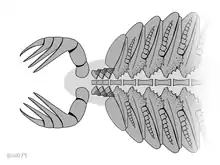Parapeytoia
Parapeytoia was a prehistoric animal that lived over 530 million years ago (Cambrian Stage 3) in the Maotianshan shales of prehistoric China. It was interpreted as an anomalocaridid (radiodont) with legs,[1] but later studies reveal it was a megacheiran,[2][3][4][5] a group of arthropods which are no longer thought to be closely related to the radiodonts.[6][7]


| Parapeytoia | |
|---|---|
 | |
| Ventral structures of Parapeytoia yunnanensis | |
| Scientific classification | |
| Kingdom: | Animalia |
| Phylum: | Arthropoda |
| Class: | †Megacheira |
| Family: | †Jianfengiidae |
| Genus: | †Parapeytoia Hou, Bergstrom & Ahlberg, 1995 |
| Species: | †P. yunnanensis |
| Binomial name | |
| †Parapeytoia yunnanensis Hou, Bergstrom & Ahlberg, 1995 | |
Parapeytoia is known from a few incomplete fossil materials with part of its ventral structures preserved. The frontmost appendages were a pair of great appendages that had a peduncle and 4 spines on each of them, a characteristic feature shared by other megacheirans such as Yohoia and Fortiforceps.[8] Behind the great appendages were 2 or 3 pairs of short appendages, and numerous pairs of well-developed biramous appendages, each formed by a basipod with spiny gnathobase, lobe-like exopod and leg-like endopod with 8 segments. A narrow sternite associated between each of those appendages.[1]
Some features originally interpreted as anomalocaridid-like are more or less questionable, such as radial sclerites interpreted as its mouthparts have since been assigned to another genus of animal, Omnidens.[9]
Parapeytoia was in all likelihood a benthic feeder, spending most of its time on the ocean floor hunting (or possibly scavenging) for prey.[2]
References
- Xian‐Guang, Hou; Bergström, Jan; Ahlberg, Per (1995-09-01). "Anomalocaris and other large animals in the lower Cambrian Chengjiang fauna of southwest China". GFF. 117 (3): 163–183. doi:10.1080/11035899509546213. ISSN 1103-5897.
- Xian-Guang, Hou; Siveter, David J.; Siveter, Derek J.; Aldridge, Richard J.; Pei-Yun, Cong; Gabbott, Sarah E.; Xiao-Ya, Ma; Purnell, Mark A.; Williams, Mark (2017-04-24). The Cambrian Fossils of Chengjiang, China: The Flowering of Early Animal Life. John Wiley & Sons. ISBN 9781118896389.
- Daley, Allison C.; Budd, Graham E.; Caron, Jean-Bernard; Edgecombe, Gregory D.; Collins, Desmond (2009-03-20). "The Burgess Shale Anomalocaridid Hurdia and Its Significance for Early Euarthropod Evolution". Science. 323 (5921): 1597–1600. doi:10.1126/science.1169514. ISSN 0036-8075. PMID 19299617.
- Stein, Martin (2010-03-01). "A new arthropod from the Early Cambrian of North Greenland, with a 'great appendage'-like antennula". Zoological Journal of the Linnean Society. 158 (3): 477–500. doi:10.1111/j.1096-3642.2009.00562.x. ISSN 0024-4082.
- Daley, Allison C.; Edgecombe, Gregory D. (2014). "Morphology of Anomalocaris canadensis from the Burgess Shale". Journal of Paleontology. 88 (1): 68–91. doi:10.1666/13-067. ISSN 0022-3360.
- Van Roy, Peter; Daley, Allison C.; Briggs, Derek E. G. (2015-06-04). "Anomalocaridid trunk limb homology revealed by a giant filter-feeder with paired flaps". Nature. 522 (7554): 77–80. doi:10.1038/nature14256. ISSN 1476-4687. PMID 25762145.
- Ortega-Hernández, Javier; Janssen, Ralf; Budd, Graham E. (2017-05-01). "Origin and evolution of the panarthropod head – A palaeobiological and developmental perspective". Arthropod Structure & Development. Evolution of Segmentation. 46 (3): 354–379. doi:10.1016/j.asd.2016.10.011. ISSN 1467-8039. PMID 27989966.
- Haug, Joachim T.; Waloszek, Dieter; Maas, Andreas; Liu, Yu; Haug, Carolin (March 2012). "Functional morphology, ontogeny and evolution of mantis shrimp-like predators in the Cambrian: MANTIS SHRIMP-LIKE CAMBRIAN PREDATORS". Palaeontology. 55 (2): 369–399. doi:10.1111/j.1475-4983.2011.01124.x.
- Hou, Xianguang; Bergström, Jan; Jie, Yang (2006). "Distinguishing anomalocaridids from arthropods and priapulids". Geological Journal. 41 (3–4): 259–269. doi:10.1002/gj.1050.
- Dinocaridids: anomalous arthropods or arthropod-like worms? by Hou Xianguang & Jan Bergström 2006 arguing that this genus is a dinocaridid